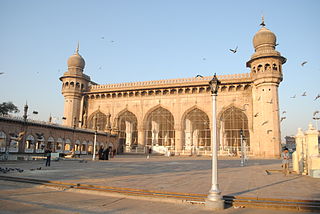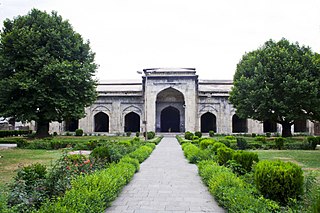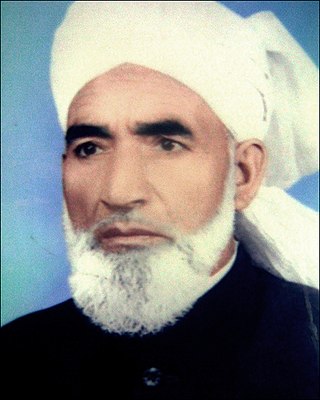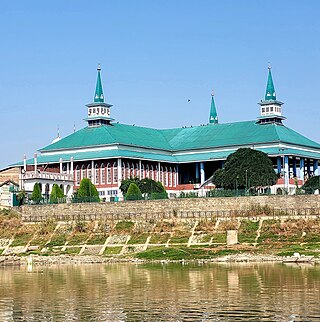Nowhatta, known as Navyut in Kashmiri, is a town of historical importance situated at a distance of 5 km from Lal Chowk, Srinagar in Jammu and Kashmir, India. Nowhatta is famous because of Historical Mosque known as Jamia Masjid. Nowhatta area has eighteen sub-communities Mohalla. The place is also notable for high rate of stone pelting incidents in Kashmir. Each week after Friday prayers, people stage their protest against Indian rule which most of the times results in stone pelting incidents in the area.

Makkah Masjid or Mecca Masjid, is a congregational mosque in Hyderabad, India. It is the largest mosque in the city, and one of the largest in the country, with a capacity of 10,000 people. The mosque was built during the 17th century, and is a state-protected monument. It serves as the primary mosque for the Old City of Hyderabad, and is located close to the historic landmarks of Charminar, Chowmahalla Palace and Laad Bazaar.

Indo-Islamic architecture is the architecture of the Indian subcontinent produced by and for Islamic patrons and purposes. Despite an initial Arab presence in Sindh, the development of Indo-Islamic architecture began in earnest with the establishment of Delhi as the capital of the Ghurid dynasty in 1193. Succeeding the Ghurids was the Delhi Sultanate, a series of Central Asian dynasties that consolidated much of North, East, and Central India, and later by the Mughal Empire during the early 16th century. Both of these dynasties introduced Islamic architecture and art styles from West Asia into the Indian subcontinent.

The Shah Mir dynasty or the House of Shah Mir, was a Kashmiri dynasty that ruled the Kashmir Sultanate in the Indian subcontinent. The dynasty is named after its founder, Shah Mir.

Mirwaiz Mohammad Umar Farooq is the 14th Mirwaiz of Kashmir. He is a Kashmiri separatist political leader. He is also an Islamic religious cleric of Kashmir Valley.
Mirwaiz is a hereditary institution of head priests that is unique to the Kashmir Valley. The traditional role of mirwaizes is to provide religious education in the shrines and mosques. Over time, the mirwaizes also took up social, cultural and political activities.

Mohammad Farooq Shah commonly known as Mirwaiz Moluvi Mohammad Farooq was the Mirwaiz of his time in Kashmir—north of India— and chairman of All Jammu and Kashmir Awami Action Committee, a coalition of disparate political parties in Jammu and Kashmir that sought resolution of the Kashmir conflict.

The Bijapur Fort is located in the Bijapur city in Bijapur District of the Indian state of Karnataka. Bijapur fort has a plethora of historical monuments of architectural importance built during the rule of Adil Shahi dynasty.

Jama Masjid, also known as Jumah Mosque or Jami' Masjid, is a mosque in Ahmedabad, Gujarat, India. It was built in 1424 during the reign of Ahmad Shah I. The inscription on the central mihrab commemorates the inauguration of the mosque on the 1st Safar A.H. 827 or January 4, 1424 A.D. by Sultan Ahmad Shah I. The mosque lies in the old walled city, and it is situated outside Bhadra Fort area. The old walled city is divided into separate quarters or pols, and the Jami' Masjid is found on the Gandhi Road. Along the south side of the road, the mosque is a short distance beyond the Teen Darwaza or Tripolia Gate.

Baro Shona Masjid, also known as Baroduari Masjid, is located in Gour, West Bengal, India. Completed in 1526, it is situated half a kilometer south of Ramkeli, a village on the way to Gour, and 12 km south of Malda. The mosque with its ruins can be found very close to the India-Bangladesh border. With a gigantic rectangular structure of brick and stone, this mosque is the largest monument in Gour. Even though one of the mosque's names "Baroduari Masjid" implies that it has 12 doors, it actually has eleven in its current state.
Shangus is an assembly constituency and a tehsil in Anantnag district of the Indian union territory of Jammu and Kashmir. It is the biggest village in Anantnag District in terms of Population and area. Jamia Masjid Shangus popular as Masjid e Mukaram is the 2nd largest Masjid in J&K after Jamia Masjid, Srinagar.The old Jama Masjid shangus was the third-largest mosque in Kashmir,after Srinagar and shopian built on the pattern of Srinagar and Shopian Jamia Masjids. It was heavily influenced by Persian architecture and has a square garden in the middle. The construction of the mosque started on 9 November 1949, and was completed in 1955, taking around 6 years at that time. According to ancestors, when the fundraising began, it was around 300 rupee first time & then money for the construction of the mosque was collected from the whole area, totaling 18,000 rupees at that time during the inaugural construction. Later, it was upgraded and decorated over time to time In 2020, it was decided that reconstruction should take place by the local body of auqaf but it took some time because of COVID that time .The reconstruction started with a stone-laying ceremony on 13 August 2021, and is continuing to this date. Its area was increased from two sides, making it the second-largest mosque in all of Kashmir after Historic Srinagar jamia masjid & taking over shopian mosque. If you want to visit, you can simply reach Shangus via Achabal or, which is just 6-7 km away or through mattan side u can also reach shangus.It is located on the road leading to Anantnag East (Islamabad) areas like Wangam, Isso, Ranipora,brah telwani etc.The auqaf building is just adjacent to jamia masjid.{Note:Whoever has edited before please provide the correct info-SIA}

Persian Inscriptions on Indian Monuments is a book written in Persian by Dr Ali Asghar Hekmat E Shirazi and published in 1956 and 1958 and 2013. New edition contains the Persian texts of more than 200 epigraphical inscriptions found on historical monuments in India, many of which are currently listed as national heritage sites or registered as UNESCO world heritage, published in Persian; an English edition is also being printed.

Aali Mosque or Ali Mosque is a mosque located in the Srinagar city of Jammu and Kashmir, India. It was Built by Sultan Ali Shah in 1395 AD, who was the elder brother of Sultan Zain al-Abidin (Budshah) and named after Sultan Ali Shah himself..It is also believed to have been constructed in 1471 AD during the reign of Shamiri king Sultan Hassan Shah and named after Sayyid Ali Hamadani (Shah Hamdan). The structure is the largest existing mosque within the premises of Eidgah Srinagar, which is also named after Sayyid Ali Hamadani. It is also the second largest mosque in the Kashmir Valley after the Jamia Masjid, also located in Srinagar. The building shows a unique synthesis between Central Asian and local traditions of wooden architecture. The mosque is based on a 4m×4m grid supported on 5 m 151 wooden columns of 0.95 m girth. The main hall on the ground floor measuring 61.2 m by 20.5 m consists of 75 such modules. All 151 deodar columns are rested on carved stone pedestals with varying designs. The overall area of the mosque is 1844 m2.

Khanqah-e-Moula, also known as Shah-e-Hamadan Masjid and Khanqah, is a mosque located in the Old City of Srinagar in Jammu and Kashmir, India. Situated on the right bank of the river Jhelum between the Fateh Kadal and Zaina Kadal bridges, it was built in 1395 CE, commissioned by Sultan Sikendar in memory of Mir Sayyid Ali Hamadani. It is held to be the first Khanqah—mosques associated with specific saints—in the Kashmir valley. It is one of the best examples of Kashmiri wooden architecture, and is decorated with papier mache.

Pathar Mosque, known locally as Naev Masheed, is a Mughal era stone mosque located in the old city of Srinagar, in the Indian state of Jammu and Kashmir. It is located on the left bank of the River Jhelum, just opposite the shrine of Khanqah-e-Moula. It was built by Mughal Empress Noor Jehan, the wife of emperor Jehangir, in 1623, for Shi’a Muslim Population. Soon after its construction, the mosque was declared unfit for prayers and was used instead for non-religious purposes. The structure was reconverted into a mosque in the early 1930s. The mosque has some distinct features that separate it from the rest of the mosques in the Kashmir Valley. Unlike other mosques, it does not have the traditional pyramidal roof. Furthermore, the mosque has nine mehraabs (arches), with the central one being larger than the others.

Sir Syed Sani Syed Ali Shah Bukhari commonly known as Ali Shah, Sir Syed Sani, Molvi Saeeb, Sir Syed Kashmir, Chirag-i-Beerwah, or Musleh-Millat, was a 20th-century Kashmiri Muslim pragmatist, Islamic modernist, philosopher, Islamic jurist, social activist and educator in the tehsil Beerwah of the Budgam district of Jammu and Kashmir. He was the khateeb, Imam and Mirwaiz of the Grand Jamia Masjid Beerwah.

The 2017 Nowhatta mob lynching, was the lynch mob murder and mutilation of an on-duty undercover Indian Jammu and Kashmir Police officer Muhammad Ayub Pandith, on the Muslim holy night of Laylat al-Qadr on Thursday 22 June 2017 by a mob in Nowhatta after a crowd shouted slogans in favor of Pakistan as well as al-Qaida jihadist Zakir Musa. Sajjad Ahmad Gilkar, a Hizbul Mujahideen militant, had played a key role in the lynching according to the state police.

Jama Masjid is a mosque in Shopian is a historic mosque located in the district of Shopian, in the Indian-administered union territory of Jammu and Kashmir. This mosque is said to have been built during the Mughal period and is very beautiful from both inside and outside. It's considered one of the best mosques in the Shopian district.

Jamia Masjid Sopore, also known as Jamia Qadim Masjid is a historic mosque located in Sopore, Jammu and Kashmir, India. The mosque was originally constructed in the 17th century during the reign of the Mughal Emperor Aurangzeb. It is the largest mosque in the area and serves as a central hub for religious activities, especially Friday, Eid, and Shab-e-Qadr congregations. The mosque is situated on the banks of the River Jhelum, providing a serene and picturesque setting.






















